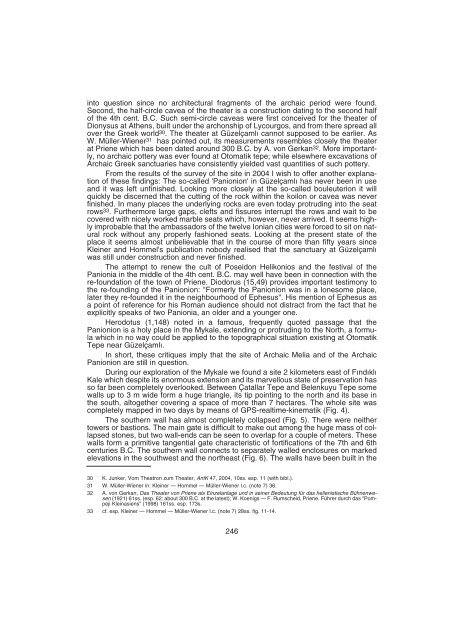23. araÅtırma sonuçları toplantısı 1. cilt - Kültür ve Turizm BakanlıÄı
23. araÅtırma sonuçları toplantısı 1. cilt - Kültür ve Turizm BakanlıÄı
23. araÅtırma sonuçları toplantısı 1. cilt - Kültür ve Turizm BakanlıÄı
You also want an ePaper? Increase the reach of your titles
YUMPU automatically turns print PDFs into web optimized ePapers that Google loves.
into question since no architectural fragments of the archaic period were found.<br />
Second, the half-circle ca<strong>ve</strong>a of the theater is a construction dating to the second half<br />
of the 4th cent. B.C. Such semi-circle ca<strong>ve</strong>as were first concei<strong>ve</strong>d for the theater of<br />
Dionysus at Athens, built under the archonship of Lycourgos, and from there spread all<br />
o<strong>ve</strong>r the Greek world 30 . The theater at Güzelçaml› cannot supposed to be earlier. As<br />
W. Müller-Wiener 31 has pointed out, its measurements resembles closely the theater<br />
at Priene which has been dated around 300 B.C. by A. von Gerkan 32 . More importantly,<br />
no archaic pottery was e<strong>ve</strong>r found at Otomatik tepe; while elsewhere excavations of<br />
Archaic Greek sanctuaries ha<strong>ve</strong> consistently yielded vast quantities of such pottery.<br />
From the results of the sur<strong>ve</strong>y of the site in 2004 I wish to offer another explanation<br />
of these findings: The so-called 'Panionion' in Güzelçaml› has ne<strong>ve</strong>r been in use<br />
and it was left unfinished. Looking more closely at the so-called bouleuterion it will<br />
quickly be discerned that the cutting of the rock within the koilon or ca<strong>ve</strong>a was ne<strong>ve</strong>r<br />
finished. In many places the underlying rocks are e<strong>ve</strong>n today protruding into the seat<br />
rows 33 . Furthermore large gaps, clefts and fissures interrupt the rows and wait to be<br />
co<strong>ve</strong>red with nicely worked marble seats which, howe<strong>ve</strong>r, ne<strong>ve</strong>r arri<strong>ve</strong>d. It seems highly<br />
improbable that the ambassadors of the twel<strong>ve</strong> Ionian cities were forced to sit on natural<br />
rock without any properly fashioned seats. Looking at the present state of the<br />
place it seems almost unbelievable that in the course of more than fifty years since<br />
Kleiner and Hommel's publication nobody realised that the sanctuary at Güzelçaml›<br />
was still under construction and ne<strong>ve</strong>r finished.<br />
The attempt to renew the cult of Poseidon Helikonios and the festival of the<br />
Panionia in the middle of the 4th cent. B.C. may well ha<strong>ve</strong> been in connection with the<br />
re-foundation of the town of Priene. Diodorus (15,49) provides important testimony to<br />
the re-founding of the Panionion: "Formerly the Panionion was in a lonesome place,<br />
later they re-founded it in the neighbourhood of Ephesus". His mention of Ephesus as<br />
a point of reference for his Roman audience should not distract from the fact that he<br />
explicitly speaks of two Panionia, an older and a younger one.<br />
Herodotus (1,148) noted in a famous, frequently quoted passage that the<br />
Panionion is a holy place in the Mykale, extending or protruding to the North, a formula<br />
which in no way could be applied to the topographical situation existing at Otomatik<br />
Tepe near Güzelçaml›.<br />
In short, these critiques imply that the site of Archaic Melia and of the Archaic<br />
Panionion are still in question.<br />
During our exploration of the Mykale we found a site 2 kilometers east of F›nd›kl›<br />
Kale which despite its enormous extension and its mar<strong>ve</strong>llous state of preservation has<br />
so far been completely o<strong>ve</strong>rlooked. Between Çatallar Tepe and Belenkuyu Tepe some<br />
walls up to 3 m wide form a huge triangle, its tip pointing to the north and its base in<br />
the south, altogether co<strong>ve</strong>ring a space of more than 7 hectares. The whole site was<br />
completely mapped in two days by means of GPS-realtime-kinematik (Fig. 4).<br />
The southern wall has almost completely collapsed (Fig. 5). There were neither<br />
towers or bastions. The main gate is difficult to make out among the huge mass of collapsed<br />
stones, but two wall-ends can be seen to o<strong>ve</strong>rlap for a couple of meters. These<br />
walls form a primiti<strong>ve</strong> tangential gate characteristic of fortifications of the 7th and 6th<br />
centuries B.C. The southern wall connects to separately walled enclosures on marked<br />
elevations in the southwest and the northeast (Fig. 6). The walls ha<strong>ve</strong> been built in the<br />
30 K. Junker, Vom Theatron zum Theater, AntK 47, 2004, 10ss. esp. 11 (with bibl.).<br />
31 W. Müller-Wiener in: Kleiner — Hommel — Müller-Wiener l.c. (note 7) 36.<br />
32 A. von Gerkan, Das Theater von Priene als Einzelanlage und in seiner Bedeutung für das hellenistische Bühnenwesen<br />
(1921) 61ss. (esp. 62: about 300 B.C. at the latest); W. Koenigs — F. Rumscheid, Priene. Führer durch das "Pompeji<br />
Kleinasiens" (1998) 161ss. esp. 173s.<br />
33 cf. esp. Kleiner — Hommel — Müller-Wiener l.c. (note 7) 28ss. fig. 11-14.<br />
246

















